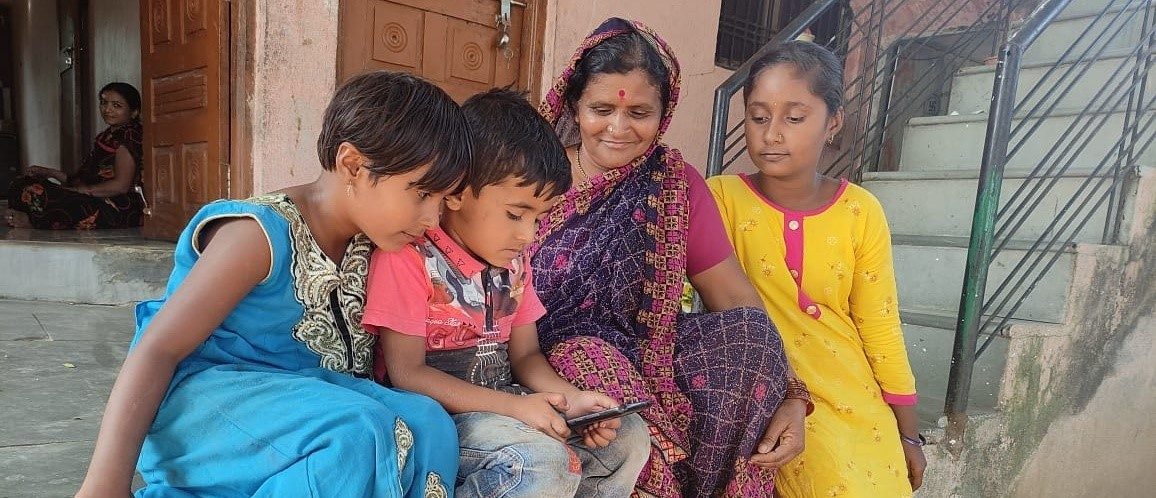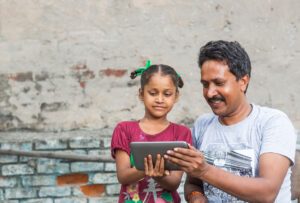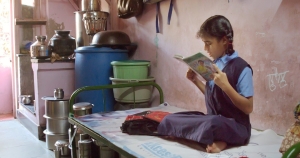Kesarbai Kulkarni of Aurangabad district is not educated, but she left no stone unturned to ensure that her grandson Samyak receives education. When schools shuttered in India to contain the spread of COVID-19, she used her precious savings to invest in technology and embrace remote learning for Samyak. We at Rocket Learning, share activity-based content with him, along with more than 1 lakh other children across three states, over WhatsApp every day.
As the country went into lockdown, Governments and private schools adopted a multitude of mediums to ensure minimum interruption to education delivery. The mediums range from TV to radio to online learning channels using phones, computers, tablets. However, WhatsApp on basic smartphones stood out as an effective solution. In rural India, a staggering 86% of children who received educational material from schools during the lockdown, received it on the phone, either over WhatsApp or over a call (ASER 2020).
The trend is understandable as smartphone penetration is much higher than devices such as laptops and tablets in low-income households. Ownership of smartphones in rural India almost doubled between 2018-2020 from 36.5% to nearly 62% (ASER 2020). Moreover, significantly lower prices clubbed with computing powers sufficient to access educational content also make smartphones a highly attractive proposition for learning. Children also have the option to learn using online applications like Byjus and Vedantu, take online classes through video calling apps like Zoom and Google Meet, or choose offline learning applications like Google Bolo and Khan Academy Kids.
However, rural India continues to face challenges to leverage smartphone-based education. In addition to challenges of access to device and consistent internet connectivity, lack of awareness about education apps, technological barriers to install and operate these apps, and limited storage space on phones become a barrier for children in remote areas. We at Rocket Learning are trying to solve these challenges and enable children from low- and middle-income households to access digital learning opportunities. We’ve adopted the ‘AIM’ framework — Aspiration, Information, and Motivation. We run programmes to inform parents about the importance of education in early school years for them to be able to fulfil their aspirations for their children; empower them with information on how best to support their child’s learning needs; and motivate them to stay engaged for the long-term in their child’s learning journey.
WhatsApp on basic smartphones stood out as an effective solution. In rural India, a staggering 86% of children who received educational material from schools during the lockdown, received it on the phone, either over WhatsApp or over a call (ASER 2020)
Building Digital Communities for Learning
Digital communication platforms like WhatsApp, Facebook Messenger, and Telegram, have emerged as potential game-changers. WhatsApp has a user base of over 400 million people and has the most active monthly users for any application in India1. Its compatibility with basic smartphones, especially with Jio phones, which aim to shift ~200 million Indians to a smartphone2 at a very low price, makes it easily accessible. Since it is a pre-installed app and used on a daily basis by most users, the barrier to set up and learn a new application for educational purposes does not exist. In fact, WhatsApp has proved successful in connecting even those children to schools who do not have direct access to a smartphone. ASER 2020 shows that ~25% of children whose families do not have smartphones, access learning material on a neighbour or relative’s phone using WhatsApp. Asynchronous downloading and sharing is a key enabler for parents with poor network or bandwidth. This enables them to download the shared learning material and access it anytime they want as opposed to joining live lessons over video calls. Teachers too are increasingly leveraging digital communication platforms for administrative and academic purposes. The ease of creating and joining these groups has led to teachers being better connected with parents and children.
Whatsapp can become effective learning platforms if we create learning communities instead of just groups. Two-way communication must be encouraged, where teachers don’t just share educational content with students but also engage them in discussions.
Unfortunately, these platforms remain largely underutilised. Approximately two third of all enrolled children did not receive any kind of learning materials or activities from their teachers during the week of the ASER 2020 survey. This is not surprising as study material sent over these platforms often flows through a multi-layered cascade — starting from education department to school administration to teachers to parents and finally to the children— and often doesn’t end up reaching the right target audience. Educators use these platforms purely as a content delivery system rather than leveraging its full potential as a learning platform involving assessments or tracking of results.
In our experience, platforms like Whatsapp can become effective learning platforms if we create learning communities instead of just groups. Two-way communication must be encouraged, where teachers don’t just share educational content with students but also engage them in discussions. They also ought to assess work shared by students and provide real time feedback while simultaneously involving parents.. Being a part of this kind of an active group can feel like the closest thing to a classroom; witnessing peers engage with learning material will motivate parents and students alike to remain engaged.
Our work at Rocket Learning of engaging children, parents, and teachers using WhatsApp in over 10,000 schools and childcare centres has shown immense promise. In some geographies, we experienced that over 80% of parents were active in WhatsApp classrooms, responding at least once each day.. Teachers likewise have been very active in encouraging parents, evaluating responses shared by them in the form of videos, and providing feedback. We are constantly innovating to find ways to increase and sustain engagement in these virtual classrooms.
Given the urgency and importance of remodelling education delivery, this is a great opportunity for digital communication platforms to explore features that will assist learning.. By introducing features that are virtual classroom friendly, such as large group video calling, tracking of video/audio viewership to name a few, they could help bridge the learning divide that is widening during this pandemic. These platforms can also partner with EdTech poviders to help parents and children access content directly rather than through a leaky information cascade. Going forward, as smartphone penetration and technology literacy increase further, it will be important to leverage these platforms to ensure last mile delivery of education, especially in rural India.



